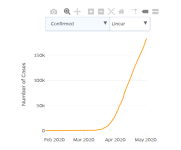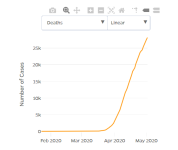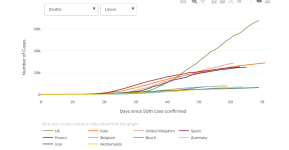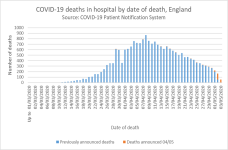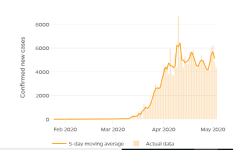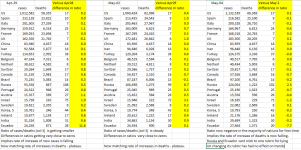What do you reckon will be the effect of the new UK numbers on your trends ? I have noticed that all the historic figures have now been adjusted upward to reflect these new 'all settings' figures. I've got all the original figures recorded, but it seems as if all graphs etc have now been reworked on these 'all settings' numbers, so there is no stepped increase from 5 days ago. What I don't understand is that if we had these figures all along, why didn't we use them
However, I believe the new 'all settings' figures are far closer to the actual.
So using the all settings figures, I believe that today's total fatality announcement of 28,489 is an actual total death figure of > 37,485.
Morning, squire.
I did two calculations after the numbers bounced up but haven't yet done today's numbers. As my statistic is the change in the ratio of new cases to deaths I expected a short blip depending on how the numbers were ajdusted, but once the adjustment has been competed (it will take a few days for this to finalise as first total deaths then total numbers of cases are recalculated, and I'm not surewhat the are doing, and even can do, about the latter) the statistic will settle back on its previous trajectory. This is because it is the change in a ratio - it isn't strongly affected by wobbles in accuracy.
As for your other question, the numbers we had all along are curated in two separate places, one that updates daily (but variably at the weekend) and the other that updates weekly. The weekly update has additionally a delay in it so it doesn't map entirely to the daliy data, and the weekly data include only deaths, not new cases as far as I can see.
Apologies if this all sounds a bit crap, and thinking about it, it is. I guess I'm not surprised because I know how some types of medical data are assembled. For example, in my research area, I asked a simple question 30 years ago: how many patients with a certain condition are give drug X, drug Y or drug Z. It took me ten years to finally realise that these drugs, used primarily in hospital, are chosen by the local committee of consultants, and this varies from hospital to hospital, and no central records of numbers and usage are kept. Thus, for an infectious disease you'd need every hospital, every GP practice (the two cases on my street were diagnosed down the phone by a nurse practitioner based on the patients' descriptions of symptoms only) to keep accurate records every time they diagnose a case, and every time they record a cause of death. So it isn't about having numbers all along; I think the government decided first to select data sources that are updated daily so a sense of trend of change could be seen (sticking to a single rubric) but have now changed this after being put under pressure for apparently grossly under reporting total deaths by inadvertently (I am being kind, here) excluding all care home deaths. I think they should have kept the two data sets separate and explained why, but they are politicians and when interfacing with Joe Public the political considerations dictate.
You are absolutely correct though that sudden big changes in the rubric for calculating any of this changes with affect the data hugely, albeit I don't think the noise will have a long term effect on my statistic. We shall see....it will be obvious as the UK numbers will suddenly stand out from the rest of the civilised world's.
As others have said repeatledly total number of deaths is ostensibly the key ststistic for assessing trends, albeit the exact numbers are questionable. As others have said in most countries this number is going down. In the worst performing nations it is too early to say. Those nations are Brazil, USA and, er, UK.



